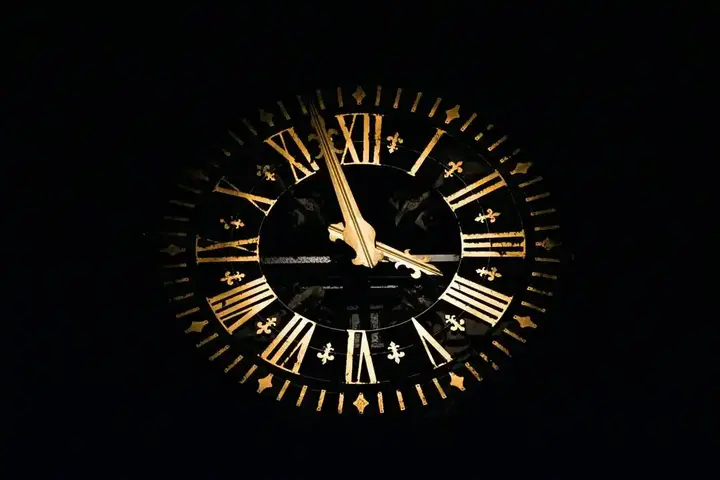Why is a minute divided into 60 seconds, an hour into 60 minutes, with only 24 hours a day?
In today's world, the most commonly used number system is the decimal system (base 10), a system that probably arose because it made it easier for humans to count using their fingers. However, civilizations, which today were first divided into smaller parts, used different digital systems, specifically the duodecimal system (base 12) and the sexagesimal system (base 60).
Ancient evidence

Thanks to documented evidence of Egyptian use of sundials, most historians attribute it as the first civilization that today was divided into smaller parts. The first sundials were pegs placed in the ground indicating the time along and in the direction of the resulting shadow. As early as 1500 BC, the Egyptians developed a more advanced sundial . A T-shaped strip was placed in the ground, and this device was calibrated to divide the interval between sunrise and sunset into 12 parts. This division reflects Egypt's use of the duodenal system – the importance of the number 12 is usually attributed either to the fact that it is equal to the number of lunar cycles per year or the number of finger joints in each hand (three in each of the four fingers, except the thumb), making it possible to count to 12 with the thumb. The next generation of the sundial likely formed the first representation of what we now call the clock. Although the hours on a given day were roughly equal, their lengths vary during the year, with summer hours being much longer than winter hours.
Recommend
Without artificial light, humans in this time period viewed sunlit and dark periods as opposing worlds rather than part of the same day. Without the help of sundials, dividing the dark period between sunset and sunrise was more complicated than dividing the sunlit period. However, during the era when sundials were first used, Egyptian astronomers for the first time also observed a cluster of 36 stars that divided the circle of the sky into equal parts. The passage of night can be marked by the appearance of 18 of these stars, three of which are dedicated to each of the two twilight periods when the stars are difficult to see. The period of total darkness was marked by the remaining 12 stars, which again led to 12 sections of the night (another reference to the Duodenal system). During the New Kingdom (1550 to 1070 BC), this measurement system was simplified to use a cluster of 24 stars, 12 of which indicate the passage of night. The water clock, or water clock, was also used to record time during the night, and was probably the most accurate timekettle in the ancient world. The clock, a model of which was found in the temple of Ammon at Karnak, and dated 1400 BC, was a bowl with sloping inner surfaces to allow water pressure to be reduced, and inscribed with scales indicating the division of the night into sections. 12 parts during different months.
Greek astronomers

Once light and dark hours were divided into 12 parts, the concept of a 24-hour day came into being. However, the concept of fixed-length clocks did not originate until the Hellenistic period, when Greek astronomers began to use such a system in their theoretical calculations. Hipparchus, primarily done between 147 and 127 BC, proposed dividing the day into 24 equinox hours, based on the 12 hours of daylight and 12 hours of darkness observed on equinox days. Despite this suggestion, ordinary people have continued to use seasonally varying clocks for centuries. (Fixed-length watches became popular only after mechanical watches first appeared in Europe during the fourteenth century.)
Hipparchus and other Greek astronomers used astronomical techniques previously developed by the Babylonians who resided in Mesopotamia. The Babylonians performed astronomical calculations using the sexagesimal system (rule 60) that they inherited from the Sumerians, who developed it around 2000 BC. Although it is not known why 60 was chosen, it is particularly suitable for expressing fractions, as 60 is the smallest number divisible by the first six counting numbers as well as by 10, 12, 15, 20, and 30. For general calculations, the sexagesimal system is still used to measure angles, geographic coordinates, and time. In fact, both the circular face of the clock and the globe owe their division into a 4,000-year-old digital system for the Babylonians. The Greek astronomer Eratosthenes (who lived around 276 to 194 BCE) used the sexagesimal system to divide the circle into 60 parts in order to create an early geographic system of latitudes, where horizontal lines pass through known places on Earth at point in time. A century later, Hipparchus normalized latitudes, making them parallel and subject to geometry. He also devised a system of longitudes that encompass 360 degrees and run from north to south, from pole to pole. In his Treatise Almagest (circa 150 AD), Claudius Ptolemy explained and expanded on Hipparchus' work by dividing both the 360-degree latitude and longitude into smaller parts. Each score was divided into 60 parts, each of which was again divided into 60 smaller parts. The first section, or first minute, became known simply as the "minute." The second hash, parts minutae secundae, or "second minute", became known as the second.
Conclusion

Minutes and seconds were used in daily timekeeping only several centuries after the appearance of the Almagest. The watch screens divided the clock into halves, one-third, quarters, and sometimes even 12 parts, but never 60 parts. In fact, it was generally not understood that the watch was 60 minutes long. It was not practical for the general public to consider minutes until the first mechanical watches displaying minutes appeared towards the end of the sixteenth century. Even today, many watches and wristwatches have a one-minute resolution and do not display seconds.
![]()
Discover the Impossible: Turning Deserts into Dense Forests – Dream or Reality?
Desert greening turns dry, barren land into fertile areas using water-saving tech, solar and wind energy, and special soil treatments. One major project, the Sahara Forest Project, aims to fight drought and climate change while boosting local economies by transforming parts of the Sahara and Sahel into green spaces. more- ADVERTISEMENT
![]()
3 inspiring success stories in difficult times
Fred DeLuca’s journey from washing dishes to founding Subway proves that persistence can turn a simple idea into a global empire, while Steve Jobs and Paulo Coelho show how resilience in the face of setbacks can lead to world-changing success and creative brilliance. more- ADVERTISEMENT
![]()
The most famous data leaks in history - a list of wonders!
Big names get hacked too—Yahoo, LinkedIn, Facebook, and Canva all suffered massive data breaches, exposing millions of users’ info. These attacks didn’t just hurt reputations—they shook global cybersecurity and pushed companies to step up protection, while users were urged to change passwords and enable two-factor authentication. more- ADVERTISEMENT
![]()
Career path in the age of technology: strategies for choosing the right specialty
In a fast-changing digital world, choosing a career isn’t just about passion—it’s about understanding tech trends and staying adaptable. By aligning skills with evolving market demands and committing to lifelong learning, young professionals can build strong, future-ready careers and thrive amid constant innovation. more- ADVERTISEMENT
![]()
A book that may interest you - don't be too nice
A book that might interest you - Too Nice for Your Own Good more- ADVERTISEMENT
![]()
Valuable life skills gained from mountaineering
Mountaineering is more than climbing; it’s a journey that builds resilience, self-reliance, and teamwork. It teaches us to accept failure, embrace challenges, and grow through every step. The real reward isn’t reaching the summit, but gaining the strength and wisdom needed to navigate life itself. more- ADVERTISEMENT
![]()
Belgrade, Serbia: Europe's new food capital?
Belgrade is now a buzzing foodie hotspot where creative chefs like Vanya Pushkar and Filip Seric reinvent traditional Serbian dishes with fresh flair. From smoked duck with herbs to grilled belly with currant sauce, the city's modern cuisine celebrates rich local flavors in vibrant, stylish settings. more- ADVERTISEMENT
![]()
Sacred places in the Andes: 7 secrets of Machu Picchu
Machu Picchu isn't truly the lost city of the Incas, and it's not as forgotten as once believed—locals were living there when rediscovered. Many marvels are hidden underground, and if you're up for a sweaty climb, you can skip the pricey bus and enjoy epic views for free. more- ADVERTISEMENT
![]()
3 undeniable signs that you are on the right path
When fear grips you, isolation surrounds you, and strange coincidences start to appear—don’t worry. These are signs you’re on the right path. Embrace the journey, trust your growth, and remember: returning to your true self is the most magical part of it all. more- ADVERTISEMENT
![]()
The Search for the Lost Temple of Artemis: A Journey Through Time and Secrets
Hunting for the Lost Temple of Artemis-A Journey Through Time and Mystery more- ADVERTISEMENT





















